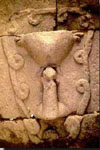BHINNEKA TUNGGAL IKA
The Story of Majapahit Mpu Sindok Airlangga Rajasa Dynasty Joko Dolog Kertanagara Raden Wijaya Shiwa - Budha Gajah MadaTROWULAN
Bajang Ratu Temple Kedaton Temple Tomb of Princess from Champa Tikus Temple Pendopo Agung Trowulan MuseumSiti Inggil GraveyardMAJAPAHIT IN DECLINE
THE TEMPLE OF MAJAPAHIT
Archithectural Style Majapahit's Sites Winginlawang Temple Kidal Temple Singosari Temple Jajaghu Temple Sumberawan Temple Sumberjati Temple Sawentar Temple Rimbi Temple Penataran Temple Tigowangi and Surawana Temple Jabung Temple Mt. Penanggungan Sukuh and Ceto TempleJedong Temple Gentong Temple Kesiman Temple Pasetran Temple Reco LanangGENEALOGY OF THE RAJASA DYNASTY
Sukuh And Ceto Temple
At Sukuh, situated 910 metres above sea-level, the site comprises three terraces, which in former times were approached from the plains by means of a long, stone stairway. The main building, located on the topmost terrace, takes the form of a flat topped pyramid, about six metres high. Narrow steps lead up through the building to the upper level, where religious ceremonies were no doubt once performed. The remains of a water system discovered on and around the pyramid suggest a connection with these rituals.
The strange imagery at Candi Sukuh has often
been compared with that of ancient Mexico, or
even Egypt! Yet, despite the curious style, the
contents of the reliefs and sculptured forms
are unmistakeably Hindu-Javanese. The emphasis,
however, lies on mystical themes dealing with
the process of deliverance, or 'liberation' of
the soul. Thus we find the story of the Sudamala,
the 'deliverance of Durga', as well as that of
Garuda freeing his mother from enslavement by
serpents. These stories of Indian origin, into
which the Javanese wayang heroes make their entrance,
became especially popular towards the end of
the Majapahit period. Dated inscriptions discovered
at Candi Sukuh range from between
|











 Dating
from around the same time as the later remains
to be found on Mt Penanggungan, the terraced
sites at Sukuh and Ceto on the western slope
of Mt Lawu are unique examples of a late Majapahit
architectural style. This was one in which the
formal elements of Hinduism and Buddhism became
absorbed by local beliefs. The traditional respect
shown towards ancestral spirits emerged to play
a central role in religious ceremony. It appears
that the temples of Sukuh and Ceto became mediums
for the deliverance of the souls of deceased
ancestors.
Dating
from around the same time as the later remains
to be found on Mt Penanggungan, the terraced
sites at Sukuh and Ceto on the western slope
of Mt Lawu are unique examples of a late Majapahit
architectural style. This was one in which the
formal elements of Hinduism and Buddhism became
absorbed by local beliefs. The traditional respect
shown towards ancestral spirits emerged to play
a central role in religious ceremony. It appears
that the temples of Sukuh and Ceto became mediums
for the deliverance of the souls of deceased
ancestors. The
complex is entered from the western end of the
lowest terrace via a small stone pavilion. The
floor of the narrow entrance passage is decorated
with the realistic image of a lingga / yoni,
carved in relief. This symbol, as well as many
others to be found within the temple site, appears
to be connected with ancient fertility rites
and ancestral cults.
The
complex is entered from the western end of the
lowest terrace via a small stone pavilion. The
floor of the narrow entrance passage is decorated
with the realistic image of a lingga / yoni,
carved in relief. This symbol, as well as many
others to be found within the temple site, appears
to be connected with ancient fertility rites
and ancestral cults. A.D.
1416 and 1456. The other important site on Mt
Lawu, Candi Ceto, was built at around the same
time as Candi Sukuh. Inscriptions found at the
temple reveal dates equivalent to A.D. 1468,
1472 and 1475. As at Sukuh, Candi Ceto is laid
out on a system of terraces, which may date from
an earlier period. No less than 14 separate levels
were noted when the site was first investigated.The
unusual sculpture and relief carving at Ceto,
similar to that found at Sukuh, is still not
fully understood. The eighth terrace, in particular,
displays some unique forms. An arrangement of
stones, laid out flat, reveals the image of a
large bird, or possibly a bat, with wings outstretched,
upon which sits a stone tortoise. Connected with
this central figure are other stone images, notably
a triangle depicting nine animal figures, a lingga
with four balls placed below the top, as well
as flat, circular stones displaying seven and
nine pointed stars.
A.D.
1416 and 1456. The other important site on Mt
Lawu, Candi Ceto, was built at around the same
time as Candi Sukuh. Inscriptions found at the
temple reveal dates equivalent to A.D. 1468,
1472 and 1475. As at Sukuh, Candi Ceto is laid
out on a system of terraces, which may date from
an earlier period. No less than 14 separate levels
were noted when the site was first investigated.The
unusual sculpture and relief carving at Ceto,
similar to that found at Sukuh, is still not
fully understood. The eighth terrace, in particular,
displays some unique forms. An arrangement of
stones, laid out flat, reveals the image of a
large bird, or possibly a bat, with wings outstretched,
upon which sits a stone tortoise. Connected with
this central figure are other stone images, notably
a triangle depicting nine animal figures, a lingga
with four balls placed below the top, as well
as flat, circular stones displaying seven and
nine pointed stars.